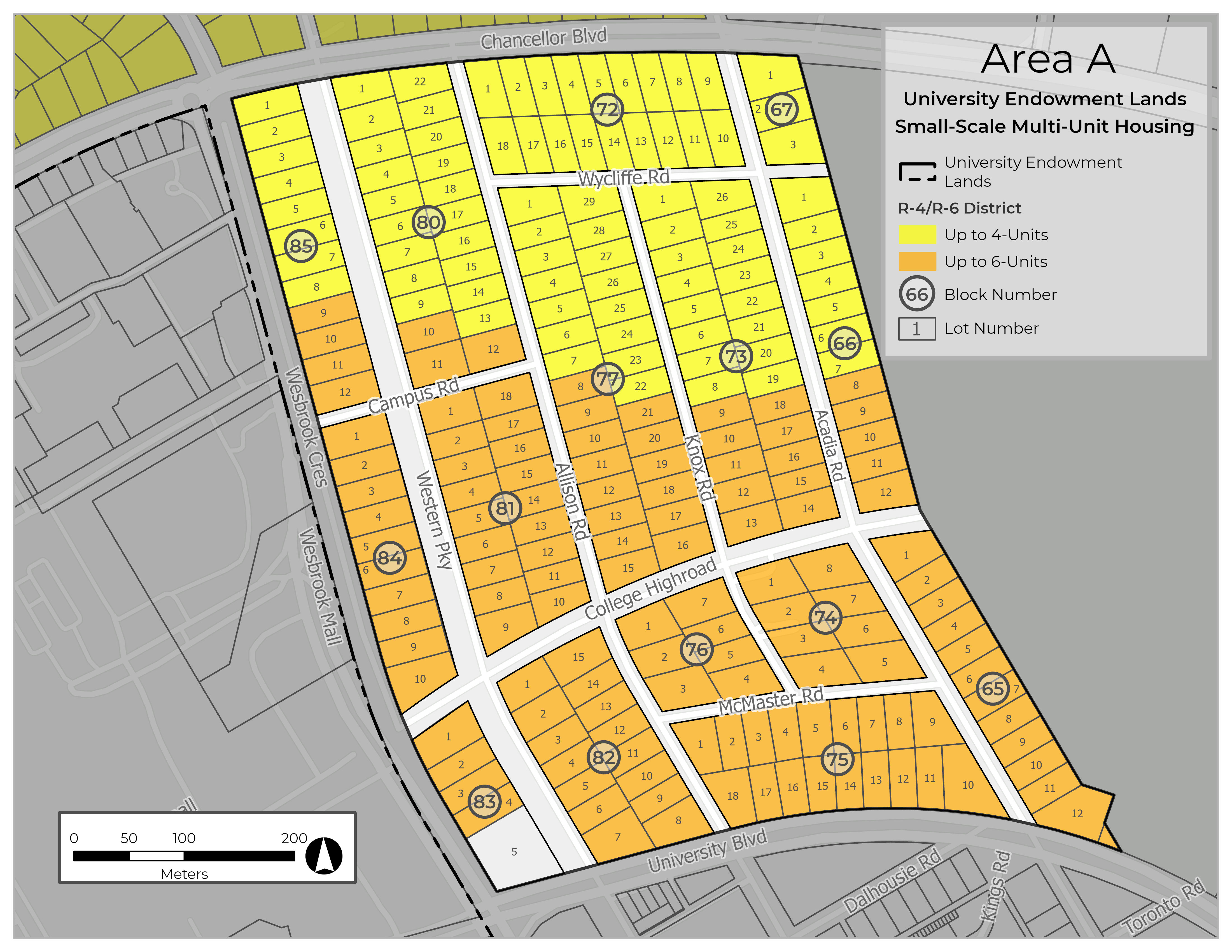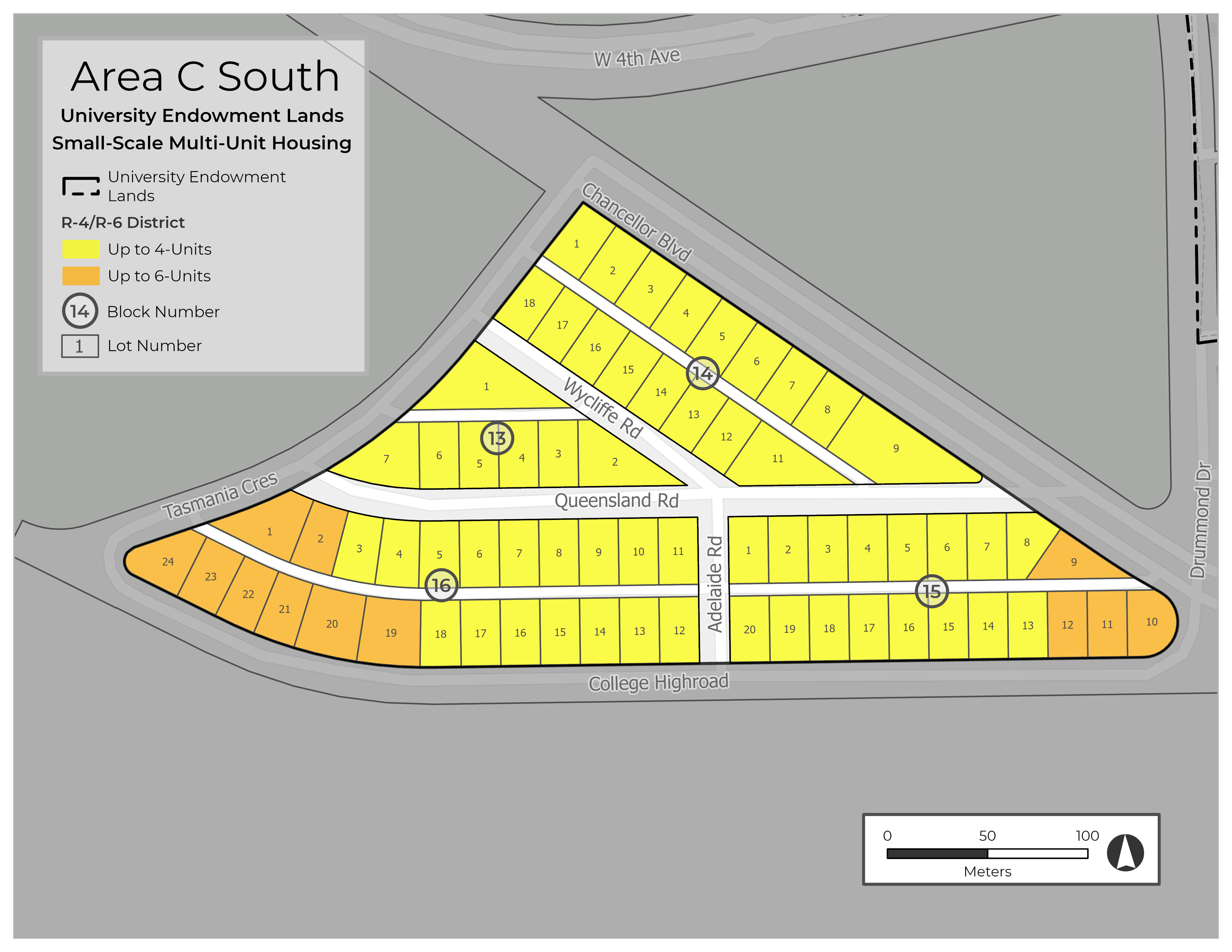Overview of New Housing Legislation
The Province of British Columbia has enacted new legislation aimed at delivering more homes for people faster. The legislation includes:- Enabling Small Scale Multi-Unit Housing (SSMUH), including Secondary Suites and Accessory Dwellings Units on most single-family lots;
- Regulations around Short-term Rentals (STRs);
- Identification of and regulations for Transit-Oriented Areas (TOAs); and,
- Refined development financing tools
The changes above will have an impact on homeowners and residents of the University Endowment Lands (UEL). For more information on the legislation please visit the Ministry of Housing website here.
Maps
Small-Scale Multi-Unit Housing (SSMUH)
 SSMUH All Areas |
 SSMUH Area A |
 SSMUH Area B |
 SSMUH Area C North |
 SSMUH Area C South |
Transit-Oriented Areas (TOA)
 TOA MAP |
 TOA MAP With Lot IDs |
Some Frequently Asked Questions (FAQs)
Abbreviations
| SSMUH | Small Scale Multi-unit Housing |
| STRs | Short-term Rentals |
| TOAs | Transit-Oriented Areas |
Transit Oriented Areas (TOA) FAQs
What is the UEL Administration doing to meet this legislation?
UEL staff are working hard to meet the goals and timelines of the legislation while also communicating with UEL homeowners and residents about these changes. Here is what we are doing:
- Aug. 21, 2024 – Updates to bylaws and regulations for SSMUH, Secondary Suites, Accessory Dwelling Units, and TOAs were approved by the Minister of Municipal Affairs. The corresponding Ministerial Order, No. M292, can be viewed here.
- Dec. 17, 2024 – An interim housing needs assessment, estimating housing needs within a 20-year time frame, was completed in accordance with new provincial standards and can be viewed here.
- Dec. 31, 2025 – Updates to Official Community Plan and zoning bylaws to align with the finalized Housing Needs Assessment.
The Province has also released policy manuals for TOAs, SSMUH, and STRs, to provide further information to all jurisdictions within British Columbia. These resources are currently being reviewed by UEL staff and can be found at the following links:
| Development Finance Tools Update - Interim Guidance |
| Provincial Policy Manual & Site Standards: SSMUH |
| Provincial Policy Manual: Transit-Oriented Areas |
Also available for reference:
| UEL Small-Scale Multi-Unit Housing Map |
| UEL Transit Oriented Development Area Housing Map |
| UEL SSMUH/TOA CAC Presentation - May 27, 2024 |
As a property owner how am I affected by this new legislation?
You will have more development options as a single-family homeowner, or owner of other residential zoned properties, within the UEL's jurisdiction. Options include
- Secondary Suites are now permitted within all of the UEL's single-family zones (SF-1 and SF-2). However, they must be supported by a building permit and identified on plans as part of a development permit. More guidance is to come.
- SSMUH is now permitted within all single-family zones (SF-1 and SF-2) within the UEL. Most lots will be subject to a maximum of 4 units, while those lots near frequent transit may have up to 6. More guidance is to come, and some exemptions may apply. Please contact the UEL office for more information.
- STRs continue to be a restricted land use within the UEL. See section below.
- TOAs, the Minister of Municipal Affairs has directed the UEL Administration to designate the UBC Bus Exchange as a Transit-Oriented Development Area as it relates to UEL land. The Administration is required to:
- Ensure that minimum levels of density, size, and dimension established by the Province in regulations are allowed in TOAs. The UEL can approve densities that exceed the provincial regulations at its discretion.
- Remove restrictive parking minimums for off-street residential parking and allow parking volumes to be determined by market need and demand
- Consider guidance and details in the provincial policy manual when planning or amending zoning bylaws
- Excluding these changes to the Single-Family Land Use Districts, all other UEL bylaws and regulations remain in place.
The UEL Administration is currently undertaking a review of a variety of development financing tools. Tools include Development Cost Charges (DCCs) and Amenity Cost Charges (ACCs) to fund growth related infrastructure and provide additional public amenities based on community needs. Both DCCs and ACCs are regulated by the Local Government Act (see links for more information), and may require both public comment and annual reporting. More information on interim guidance for local jurisdictions can be found here.
Further updates and information will be provided on our website and at Community Advisory Council meetings.
Are short-term rentals permitted in the UEL?
Short-term rentals (STRs) are not an approved use of single-family dwellings, accessory dwellings, or secondary suites in the R-4/R-6 Land Use District per the UEL Land Use, Building and Community Administration Bylaw (LUB). Illegal short-term rental accommodations in the UEL could also face strict penalties per BC’s short-term rental legislation. Purpose-built rental is an approved use within the R-4/R-6 Land Use District for dwellings purposely built for rent or lease under a tenancy agreement for a periodic or fixed-term tenancy as defined by the Residential Tenancy Act.
Where bed and breakfasts are considered in the MF-1, MF-2, and C Land Use Districts, this is a conditionally approved use, meaning that a Development Permit (DP) and consultation with the Advisory Design Panel are required. If the DP is approved by the UEL Manager, a business licence is needed as per Sections 23 and 24 of the LUB.